Witholding Judgment
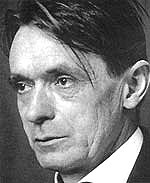
A small shift in your thinking can help you to reap enormous rewards. It doesn’t mean being a Polyanna, just thinking pausing and evaluating people and situations differently:
“Experienced spiritual researchers know what strength they gain by always looking for the good in everything and withholding their critical judgment. This practice should not remain simply an outer rule of life, but must take hold of the innermost part of the soul.”
–Rudolf Steiner (Croatian-born Austrian Mystic, Occultist, Social Philosopher, Architect and Founder of Anthroposophy, 1861-1925)

“How to Know Higher Worlds: A Modern Path of Initiation” (Rudolf Steiner)
Enjoy the World Without Judging It
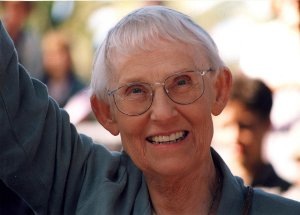
I just heard that the author of these words has recently moved on. Or as a good friend used to say: “Been promoted!”
“To enjoy the world without judgment is what a realized life is like.”
–Charlotte Joko Beck (American Zen Teacher and Author, 1917-2011)
If You Cannot Know Yourself…
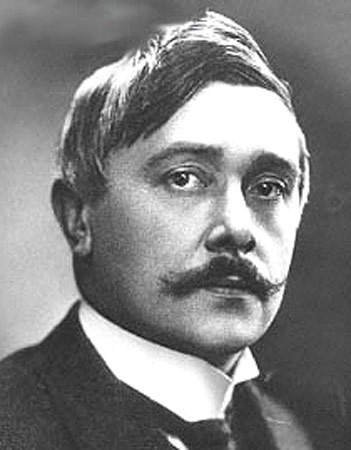
“I have never for one instant seen clearly within myself; how then would you have me judge the deeds of others?”
–Maurice Maeterlinck (Belgian Poet Writer and, in 1911, Winner of the Nobel Prize for Literature, 1862-1949)
Withholding Judgment
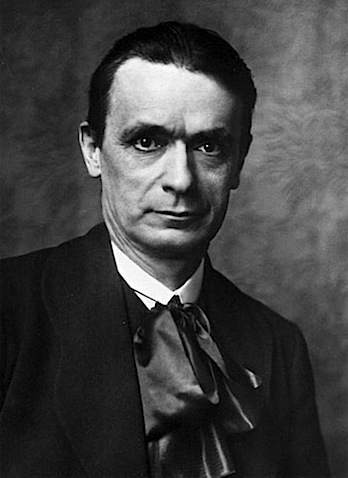
“Experienced spiritual researchers know what strength they gain by always looking for the good in everything and withholding their critical judgment.
This practice should not remain simply an outer rule of life, but must take hold of the innermost part of the soul.”
–Rudolf Steiner (Croatian-born Austrian Mystic, Occultist, Social Philosopher, Architect and Founder of Anthroposophy, 1861-1925)
Mercy and Generosity
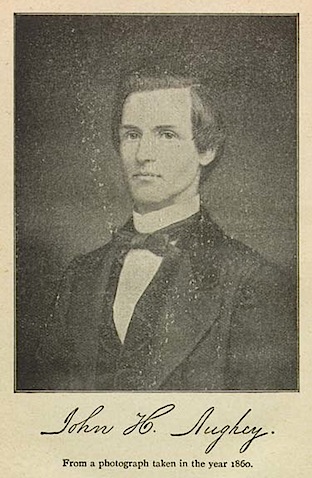
“The most generous and merciful in judgment upon the faults of others are always the most free from faults themselves.”
–John H. Aughey (a.k.a. John Hill, American Clergyman, 1828-1911)
Thinking Speed, Mood and Optimism

There’s a very interesting article at the Mixing Memory blog. It’s one of the blogs that I highlight in the “What I’m reading” section. The articles highlights some recent research by Emily Pronin and Dan Wegner from Princeton and Harvard respectively, entitled “Manic Thinking: Independent Effects of Thought Speed and Thought Content on Mood.”
It’s about an intriguing issue. People who have a manic illness have an acceleration of thinking processes together with elevated mood and energy level. Mania is also associated with racing thoughts grandiose or creative ideas, fast, uninterruptible speech, aimless pacing, irritability and an over-involvement in pleasurable activities, together with a loss of impulse control.
It may sound great, and initially people are often very happy to be manic. But after a while it can give way to exhaustion or the realization that some of their choices have been unwise. I once knew someone who was driving a brand new BMW – that she could definitely not afford – at over 120 miles an hour, the wrong way down Interstate 95. That’s when the police became involved, and they immediately realized that she was not a villain, but a very sick person who could have killed herself and a ton of other people.
The researchers they had a group of college undergraduates read a series of 58 emotion-inducing statements out loud, and to do it at either a fast or slow pace. The statements are emotionally neutral at the beginning and then become progressively more emotionally positive or negative. The idea is that reading a series of progressively more positive or negative statements will affect the reader’s mood. The letters in the statements were presented one at a time, either for 40 milliseconds per letter (“fast thinking” condition) or 170 milliseconds per letter (“slow thinking”). A pilot study indicated that the 40 milliseconds per letter reading time were about twice the normal reading speed for college undergraduates and 170 milliseconds were about half the normal speed. The time between statements also varied, with only 320 milliseconds between statements in the “fast condition” and 4 seconds between statements in the “slow condition.”
After reading all 58 statements, the participants were asked to answer a series of questions designed to assess their mood, energy level, feelings of power, creativity and inspiration. There were also questions to evaluate “grandiosity or inflated self-esteem,” together with their own perceptions of their speed of thought.
Subjects in the “fast thought” condition reported faster thought speeds than those in the “slower” condition. As predicted, faster thought speeds affected mood and mania-related feelings, participants in the fast thought condition reported being happier, had higher energy levels, experienced greater senses of power and creativity, and higher levels of grandiosity (though self-esteem did not differ between conditions). What is important, is that these effects were independent of the mood manipulation (positive or negative statements). Here is a graph from the paper presenting the effects of slow and fast thinking as a function of the type of sentence:
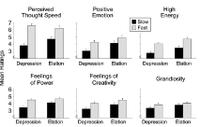
This study has some important implications. Thinking more quickly produces elevations of mood and self-perception that can smetimes be similar to those of very mild mania. I have seen this happen frequently when people have been up all night: the bright lights of morning and a few cups of coffee make them appear mildly manic. For a time they do in fact impress with their creativity and mastery not only of details, but of the “Big picture.” But as time goes on, much of their thinking turns out to be not altogether logical.
The study also raises the possibility that some manic symptoms may be produced by thinking. There is an old term from the psychoanalytic literature called “manic defense,” in which people use manic-like symptoms to protect themselves – or more accurately their ego structures – when under stress.
I have spent most of my life with people who think very quickly and accurately. Most also express themselves very well: both succinctly and fluently. But all have also known the importance of stopping for a while after a brainstorming session, so that we can see if our ideas have really born fruit, or if they just seemed a good idea at the time.
There is no question that moving and speaking more quickly can elevate our mood. It is no surprise that it has little impact on self-esteem. It is becoming more and more clear that self-esteem follows from genuine achievement. Boosting artificially is difficult, with one exception: when people have every reason to have decent self-esteem, but instead they keep feeling bad, as if they have a kind of leaky bucket as my friend the psychiatrist Stephen Preas calls it.
I remember an experiment in which an investigator was experimenting with ether. During one of his sessions he had a deeply felt mystical experience in which he was sure that he suddenly understood the whole of nature and reality. He immediately wrote it down so that he could show the world The Secret.
When he came back down to earth, he looked at what he had written, “The world is like a fish…”
“The world that we have created is a product of our thinking. It cannot be changed without changing our thinking.”
–Albert Einstein (German-born American Physicist and, in 1921, Winner of the Nobel Prize in Physics, 1879-1955
)
“Some would sooner die than think. In fact, they often do.”
–Bertrand Russell (Welsh Mathematician, Philosopher, Pacifist and, in 1950, Winner of the Nobel Prize in Literature, 1872-1970)
“Most people can’t think, most of the remainder won’t think, the small fraction who do think mostly can’t do it very well. The extremely tiny fraction who think regularly, accurately, creatively, and without self-delusion. In the long run, these are the only people who count.”
–Robert Heinlein (American Writer, 1907-1988)
Healthy Relationships are Essential to Your Health
“All of life is relationship.”
–Swami Rama (Indian Spiritual Teacher and Writer, 1925-1996)
When I first started looking at the hundreds of different therapeutic systems that we have on offer, it was striking that they all have at their core the development of a relationship between two or more individuals. One is designated the patient or client and the other the therapist who is helping the patient cure himself or herself. Until the invention of the stethoscope, which was the first step toward separating patients from those treating them, the fundamental nature of a healing relationship was well understood. Sad to say, over the last century and a half orthodox medicine began to minimize the importance of relationship to cure.
Nothing in the Universe exists in isolation: We live in a Universe of relationships. It is inconceivable that anything can exist except in relationship to something else. The entire Universe is made up of integrated systems that function, develop and evolve together. A failure to construct and maintain healthy relationships can be a cause of much distress.
Several years ago I reported some interesting observations. At the time, I was doing a lot of research on diseases of blood vessels. I had developed a laboratory method for taking some of the cells that line blood vessels from volunteers and then growing them in a cell culture dish. We discovered that if we did not have enough cells in the dish, they would all die of “loneliness.”
The exception is cancer cells, which in culture will grow on their own like weeds.
Next, we made an accidental and remarkable discovery. We normally cleared out our cell cultures once a week, but on this occasion I found that I had accidentally nudged one of the dishes to the back of the incubator, where it had been sitting for three weeks. Looking at the cells under the microscope, we could see that they had formed little tubes. Now that might not sound like very much, but it was. The cells had, inside the body of the volunteer, been part of a microscopic tube called a capillary.
To prepare the culture, the cells had been cleaned with all sorts of biochemical treatments to strip them away from everything else so that we would have no contaminating cells. The teaching for years has been that the development of cells and organs is a result of biochemical interactions between different cells of the body driven by the DNA inside the nucleus of the cells. But my cultured cells had no such cells to guide them. How could they “remember” that their role was to make tubes? The most likely explanation is that they are responding to morphic fields. I published the observation in a paper 17 years ago, and others have now replicated it.
It is estimated that at least 80% of our higher cortical functions are directed toward social functions. It is little wonder that failing to use those vast tracts of evolutionary machinery might have sad consequences.
And they do. Social isolation increases the chance of substance abuse and scores of illnesses. And people who have no social supports are much less likely to recover from many major illnesses. On the other hand, being engaged in robust, dynamic relationships provides you with powerful protections against some illnesses.
Relationships are essential to your health.
There are tens of thousands of books on relationships and I have no intention of reiterating material that has been written about a hundred times before.
But based on our principles of physical, psychological, social, subtle and spiritual, let me make these suggestions for constructing and maintaining successful relationships:
- Partnership: As I discuss in Healing, Meaning and Purpose, it is essential to examine every one of your relationships to see if it is a relationship of domination or partnership: is one person dominating and controlling the relationship, or are both people participating equally? And here is the trick. We are not only interested in the relationship between you and another person or persons, we are interested in ALL your relationships, from cell to soul.
- Maintaining wellness: all the people in a relationship should do whatever they can to maintain their physical, psychological, social subtle and spiritual well being. Nobody can avoid everything: life will throw you some curve balls, but it is most unfair to burden a relationship with avoidable health worries
- Responsibility: In the same way that you should not burden others in a relationship with avoidable health problems, you should also not burden them with needless concerns about money or other resources. Arguments about money are one of the main causes of turmoil in marriages, and it is not so much a matter of having insufficient, it is more often a matter of one person being irresponsible.
- Attention: it is essential to give the other person or persons in a relationship the attention that they deserve.
- Acceptance: This can be a hard one sometimes, and I am going to write more about acceptance shortly. Suffice to say that mature relationships require a good dose of acceptance. I have written before about an extreme case in which a woman was lamenting the fact that she could find nobody who matched her ideals in a mate. Her list of non-negotiable requirements in a partner ran to some ten pages
- Kindness: Spontaneous acts of kindness are essential to healthy relationships. If you do not want to offer kindnesses to another person it implies that there is something seriously awry n the relationship. Kindness should not be planned; it should just be part of your normal modus operandi
- Warmth and affection: Spontaneous warmth and affection are signs of a healthy relationship. But don’t think of that as holding hands and signing kumbaya, it also means being aware of the heart, the essence and the soul of the other person or persons in a relationship. If you have not recently shown some real gratitude for the other person, today might be a really good time to start.
- Laughter: Do you and your partner(s) have fun together? Are you able to share laughter and to let go of pretence? It doesn’t mean that you have to spend all day watching Laurel and Hardy or telling each other sidesplitting jokes. It means being able to find a new and healthy perspective on life and to find time to enjoy the lighter side of life.
- Conflict: do you have a healthy way of dealing with anger, conflict and resentment? All three may crop up from time to time, but the key is how you cope with them. It is simply not realistic to follow the advice that you should avoid all conflict. It’s as silly as saying the key to stress management is to avoid stress. You may as well try to avoid gravity. Stress and conflict are universal constants: the trick is learning how to deal with them. In the case of conflict the key – as always – is to communicate and to avoid toxic or corrosive habit patterns
- Listening: Listening to another person is not a matter of sitting back and allowing sound waves to set up vibrations in your auditory nerve: listening is an active learned skill that involves watching, noticing and being aware of every aspect of a communication. (You may be interested in having a look at another piece that I wrote about communication). Listening involves giving space for a communication to unfold and then asking questions and checking to ensure that both people are understanding every aspect of the exchange
- Trust: No relationship can be expected o flourish without a healthy dose of trust. Not just in the integrity of the relationship, integrity of the other person(s) involved in the relationship and trust that what you say or do will not be judged harshly
- Freedom: I have seen more relationships flounder because of a lack of freedom than almost anything else. There is a good reason why freedom is such a powerful political force. For most people, freedom to be themselves and to determine their own destiny is as important as oxygen. Ensure that your relationships have plenty of space to breathe.
“Relationships are the hallmark of the mature person.”
–Brian Tracy (Canadian-born American Author and Expert on Business and Personal Development, 1944-)








